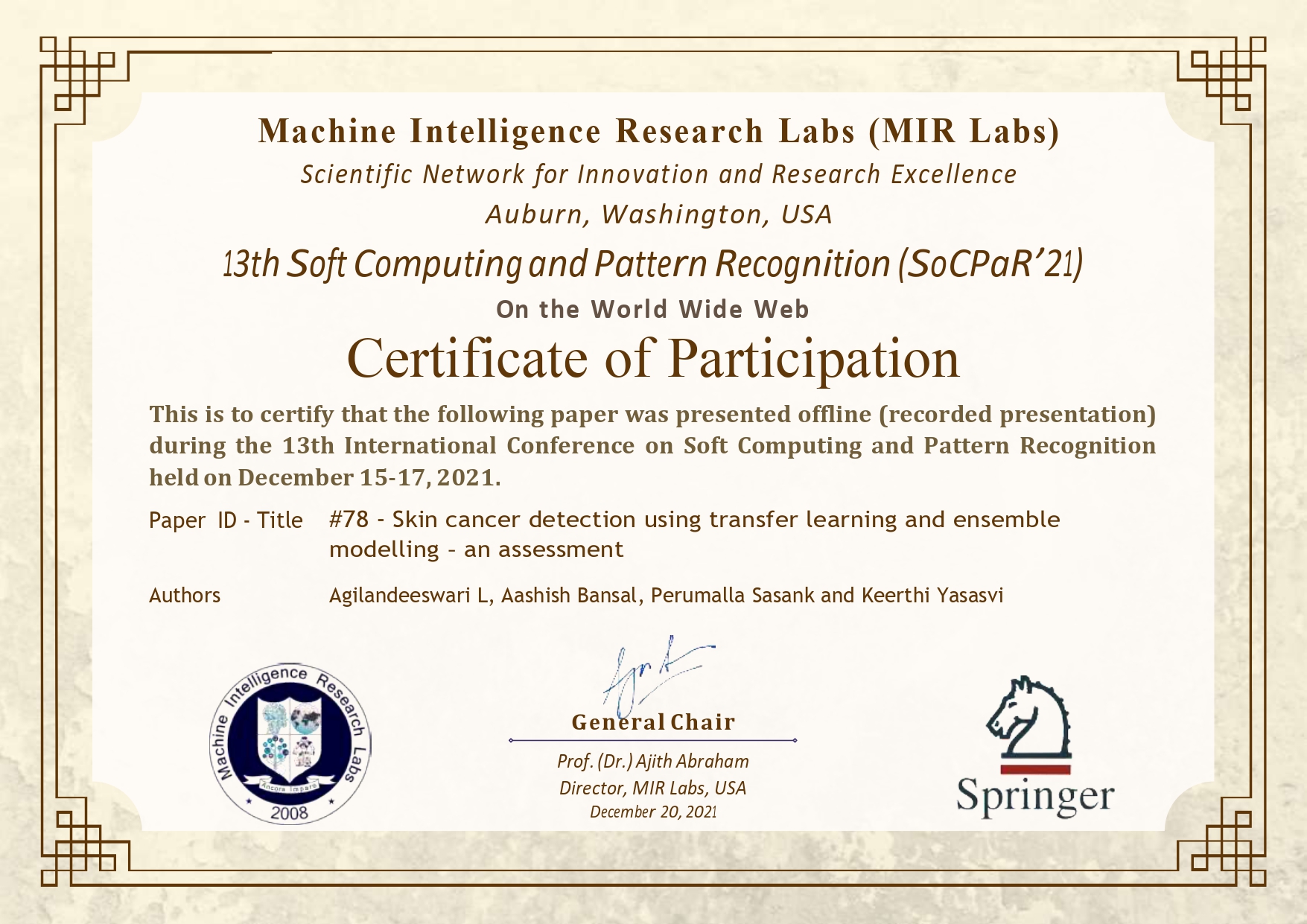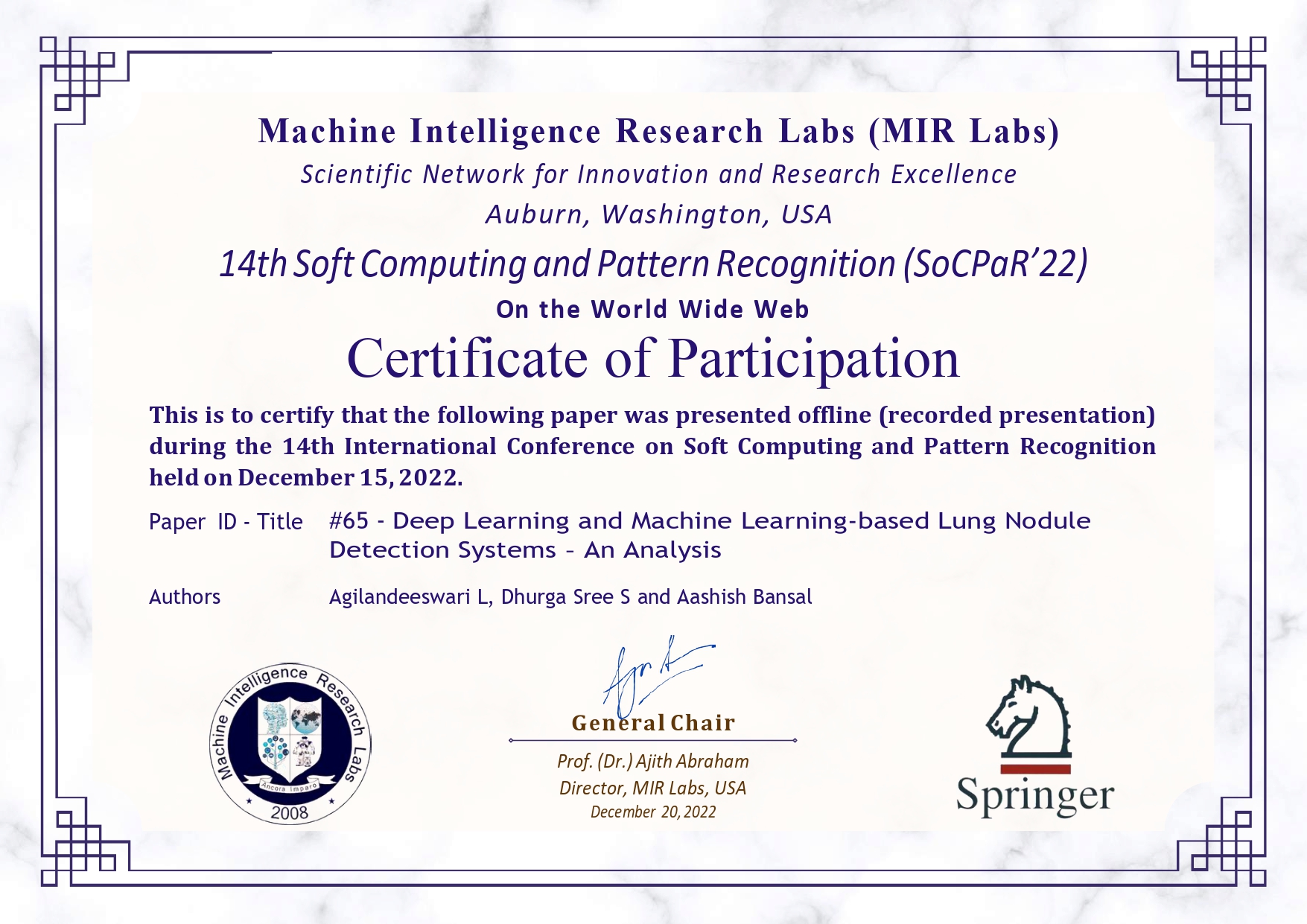Publications

Skin Cancer Detection using Transfer Learning and Ensemble Modeling - An Assessment
13th Soft Computing and Pattern Recognition (SoCPaR'21)Scientific Network for Innovation and Research Excellence, Auburn, Washington, USA
Machine Intelligence Research Labs (MIR Labs)

|
| Participation Certificate |
The project is a Transfer Learning and Ensemble Learning trained model which consists of the Mobile Net, Inception and Xception Learning pre-trained Models which can predict Skin Cancer or not by checking the scanning and predicting on the images of the infected areas on the body. The model has been trained on a variety of images through which it predicts the required. In this project, the image file of the patient is upload into a public use software, which is a GUI-based interface, developed with the help of Tkinter and Python, and it consists of the model and the software processes the image through the model and predict the results which can help people and doctors to start with the medication way earlier instead of waiting for the laboratory tests and reports for the confirmation.
Paper Link: Springer

Lung Nodule Detection based on Machine Learning and Deep Learning - An Analysis
14th Soft Computing and Pattern Recognition (SoCPaR'22)Scientific Network for Innovation and Research Excellence, Auburn, Washington, USA
Machine Intelligence Research Labs (MIR Labs)

|
| Participation Certificate |
Cancer is a condition in which the body's cells proliferate unrestrained. Lung cancer is the term for cancer that first appears in the lungs. A small abnormal spot called a lung nodule can occasionally be found during a chest CT scan in which Non-cancerous lung nodules make up the majority of them. Less than 5% of lung nodules, or 3 to 4 out of 100, turn out to be malignant. The main cause of cancer death among American men and women is lung cancer. It sur-passed breast cancer in 1987 to become the main reason why women die from cancer [16]. This encourages the early identification of cancer. Various state-of-the-art approaches used for detecting lung nodules are Deep Learning (DL) and Machine Learning (ML) based. The underlying techniques connect to the early observation of lung cancer to detect malignancy from tiny nodules with high specificity and sensitivity. This review article presents a comprehensive review of the lung nodule detection system. From this review, it is clear that the most popular lung nodule detection systems are deep learning-based CNN and machine learning-based namely SVM systems. Hybrid approaches are al-so popular nowadays. We assess the efficiency of existing state-of-the-art ap-proaches with the datasets used, and challenges faced, and recommend a path forward for high-impact future research.

Blind nonlinear unmixing using nonnegative matrix factorization based bi-objective autoencoder
Indonesian Journal of Electrical Engineering and Computer ScienceScientific Network for Innovation and Research Excellence, Auburn, Washington, USA
Machine Intelligence Research Labs (MIR Labs)
|
|
Hyperspectral image processing is one of the trending techniques used in many fields such as remote sensing, medical, agriculture, food processing, and military. The unique discrimination of hyperspectral images can be used for object identification, classification, and prediction. One of the main challenges of these tasks is the mixed pixel problem. Hyperspectral unmixing is the process of identifying the endmembers and their abundance in pixels. In linear unmixing, the mixture of the endmembers is assumed to be linear homogenous patches. Even though these models are simple and faster in performance, most of the real-world images are not linear. A modified nonlinear mixture-based sparsity regularized bi-objective autoencoder model based on nonnegative matrix factorization (NMF-BOA) is proposed in this article. The performance analysis shows that our model gives competitive results compared to the state-of-the-art models.
Full Research Paper: PDF

Vision Transformer-Based Watermark Generation for Authentication and Tamper Detection Using Schur Decomposition and Hybrid Transforms
International Journal of Computer Information Systems and Industrial Management ApplicationsISSN 2150-7988
Machine Intelligence Research Labs (MIR Labs)
|
|
Multimedia manipulation has increased which demand for security across various applications. Majorly image-oriented security issues such as image authentication, proof of ownership, and copyright protection are highly increased. To authenticate and detect the tamped region and to recover the tampered area vision transformer-based hybrid watermarking model is proposed. We proposed a novel model to achieve image authentication, tamper detection, and localization followed by image recovery. In the proposed model, invariant attention-based watermark feature maps are generated using a Vision transformer. We have generated three different watermarks: first using the SVD eigenvalue generated as an authentication watermark, secondly to detect tampered region average 6MSB of each 2*2 block generated by performing the Schur decomposition method on the biometric image, and to locate and recover the image Vision feature maps are generated and average 6MSB of each block is embedded as the tamper detection watermark. Normally the generated watermark is embedded either using an embedding factor or using a suitable embedding location. In the proposed model, watermark embedding is performed by finding the optimal embedding region using high entropy block region. On the original image, curvelet transform is performed followed by invariant integer wavelet transform. The first authentication eigenvalue is embedded on the LH band singular value diagonal matrix obtained by the SVD model. On the LL band, 2*2 blocks Schur decomposition is performed to embed the 6MSB in the 2LSB bit of upper triangular coefficient values. At last, vision feature maps are embedded in the curvelet approximate coefficient high entropy region and inverse curvelet performed, producing a watermarked image.
Full Research Paper: PDF

Network Intrusion Detection System using Machine Learning (Publication In-Progress)
Vellore Institute of TechnologyVellore, Tamil Nadu, India